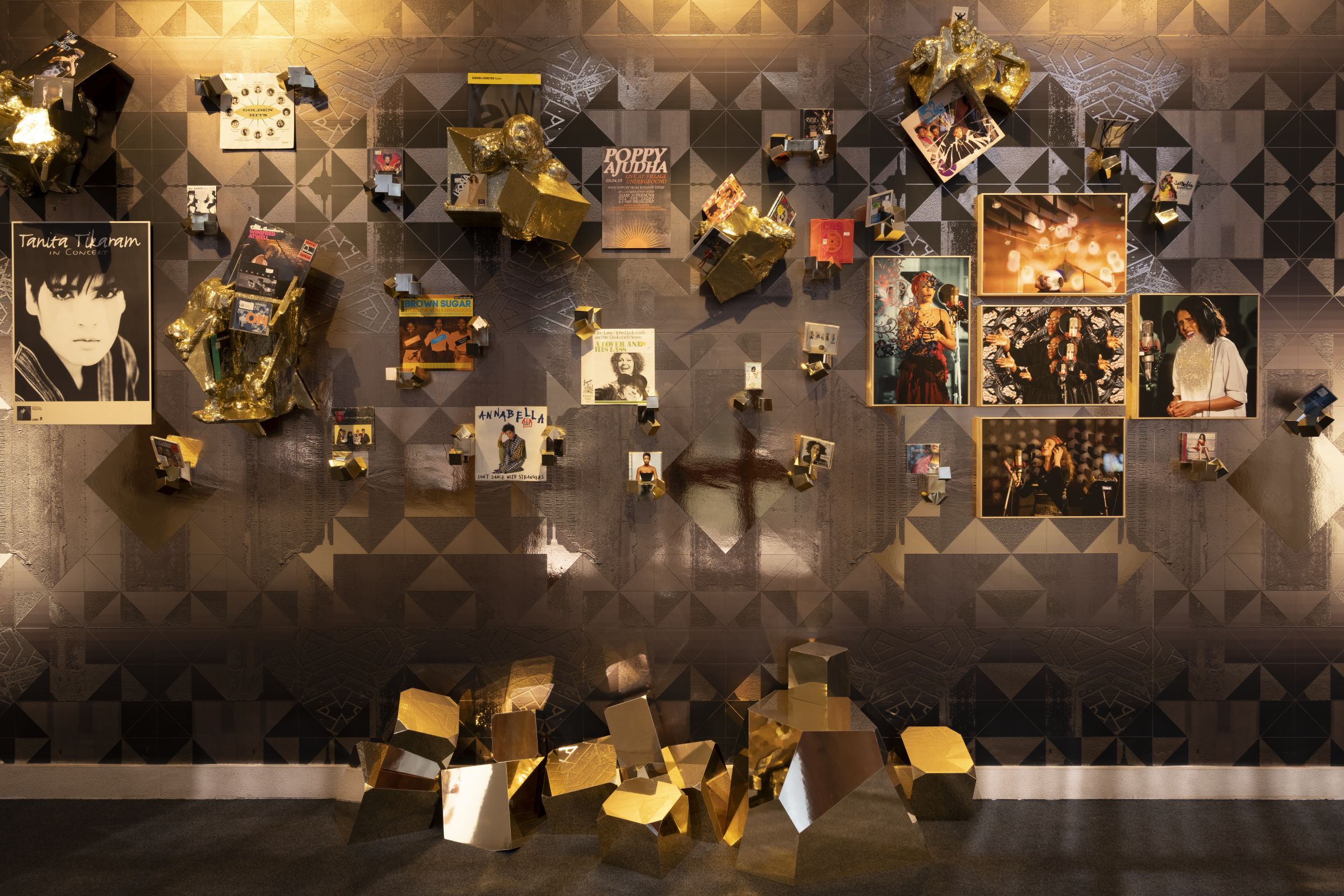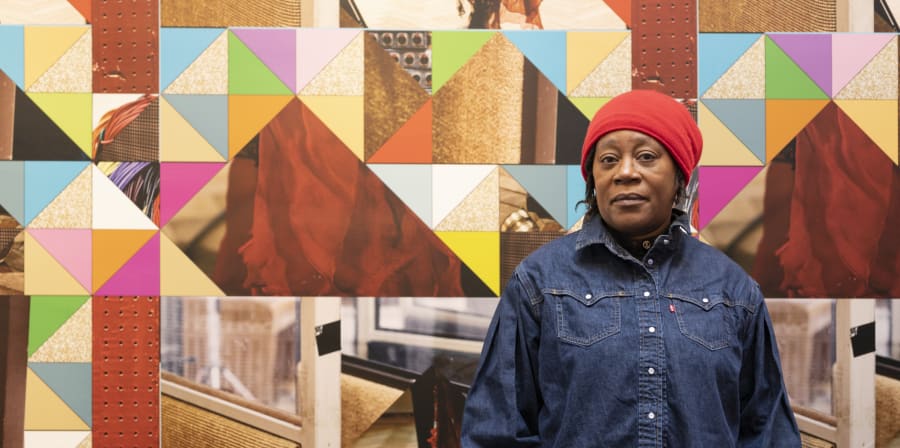
Highlights from Sonia Boyce OBE RA in conversation with Mary Evans

- Written byKat Smith
- Published date 11 July 2022

Last month, Chelsea College of Arts hosted a conversation between artists and UAL colleagues Sonia Boyce OBE RA and Mary Evans.
The event was chaired by Camberwell, Chelsea and Wimbledon Dean of Art, Sophia Phoca, and gave an exclusive insight into Sonia Boyce’s installation ‘Feeling Her Way’ which represents Britain in the 59th Venice Biennale. It also delved into the work of BA Fine Art Course Leader Mary Evans, whose work often dissects her African heritage and European upbringing.
Sophia Phoca's interest in social justice is informed by her early experience of coming to London as the child of political exiles (during the Greek military junta). She feels passionately about establishing the art school as a catalyst for social change and creating communities that embrace diversity as well as opportunity.
The speakers
Sonia Boyce
Sonia Boyce is Chair in Black Art and Design at UAL. Sonia says that in the broadest sense, her research interests lie in art as a social practice and the critical and contextual debates that arise from this burgeoning field. She is the first Black female artist to represent Britain at the Venice Biennale.
Mary Evans
Mary Evans is BA Fine Art Course Leader at Chelsea College of Arts, UAL. Evans makes site-based installations using a variety of media (paper, rubber, paint, print and digital media) on a variety of surfaces (paper, walls, flooring, glass.) Her practice is fluid and mutable in terms of her approach and the materials used.
In Conversation
The evolution of Mary Evans' practice
After an introduction from Sophia Phoca, Mary outlined the development of her work, discussing the impact of isotype (pictorial language) in her work and how a trial-and-error approach allowed her to ditch the canvas and start working with the space and architecture of a room.
It was through this approach that Mary became aware of diaspora, race and related issues. “Perhaps because I was in Amsterdam, I was away from London, away from family, away from home, I had a very specific kind of experience.
“I was an alien, apparently, even though I was an EU citizen – so I started to make work that addressed that.”
Now, Mary’s work is characterised by these themes, communicated through non-traditional mediums she uses: paper plates, doilies, gingerbread biscuits and ‘Please do not bend’ envelopes.

Introducing ‘Feeling Her Way’
Sonia Boyce began by speaking about her Venice Biennale installation - ‘Feeling Her Way’ brings together video works featuring 5 female musicians: Poppy Ajudha, Jacqui Dankworth MBE, Sofia Jernberg, Tanita Tikaram and composer Errollyn Wallen CBE, who were invited to improvise, interact and play with their voices.
The impetus for ‘Feeling Her Way’ comes from a much longer project by Sonia – the Devotional Series - where she brought women together to celebrate Black women in British entertainment. This has been an ongoing project since 1999.
"Making visible" and the use of space
Then, the event became a discussion, with Sonia and Mary examining connections that the two artists see between their works, with the use of space and making everything visible being a key similarity.
“When I go into a space I feel like I really have to respect it – I'm not going to try and change it too much. It’s the space – it's got pipes, it’s got radiators, it’s got what it’s got,” said Mary. “Often - not always – there's architectural/cultural/historical specificity attached to that space which then comes into the work as well.”
In the same vein, Sonia talked about the importance for her of seeing the people who are in spaces to be shown – such as the crew walk through the spaces – as these are the spaces in which they inhabit. “Even though there may be this performance that’s taking place that might seem like a juxtaposition that jars, this is what makes films – all these people are part of the craft.”
The three then discussed Sonia’s ‘Feeling Her Way’ and how it invites you into the space to sit and listen to each individual voice. “I thought that was very generous,” Sophia said. “I felt that it was really generous and inclusive, just the way that you were welcomed into the space and you could spend time there and think about the things that you’re talking about. That was incredibly successful, how you did that.”
“What’s the work about?”
Sonia reflected on about the difficulty of being asked what her work is about – a move away from the work she produced in the 80s which was “very much about telling people what they were seeing.” When she brought the musicians taking part in 'Feeling Her Way' together, they asked her what the meaning of the work was about – but it was more about putting them in the same room and seeing what happens, she said.

Inviting and refusing; attracting and repelling
In relation to Mary’s work, ‘Gingerbread’ (2013), Sonia asked Mary about the idea of art inviting and yet refusing. The ingredients listed on her gingerbread cookies include flour, sugar, ginger, molasses, allspice, blood, sweat and tears – this edible artwork reminds us of the dark past of slavery and the African diaspora. The figures look and smell delicious, but they are not to be consumed.
“They’re a bit of a hangover from my interest in nursery rhymes – you know how sinister nursery rhymes and children’s stories and fairy tales are. It keeps recurring – that kind of interest in the bittersweet.”
Then and now: bringing history to the forefront
With history and its relationship to the present being a key thread in both artists' work, Sonia talked about letting time leave marks in her work.
“Particularly in the fourth gallery of the pavilion, there is gold wallpaper with memorabilia that’s sat on these gold, glittery pedestals. When I was making them, most of these objects (CDs and vinyls and so forth) have come from charity shops.” Sonia didn’t want to get rid of the various price tags that were on the memorabilia – something that started off at £9.99 was now 50p. “Those price tags tell me the history of that object [...] also the way in which they’ve become devalued."
Mary agreed with the passing of time and history being key physical elements of her art – she talked about using mediums that interact with other spaces – like pasting on a wall or stamping onto a surface. “That idea of constantly leaving traces – whether it’s a price tag or wallpaper paste or whatever it might be – that accrual of the residue that becomes part of the work... is really interesting.”
The burden of being the first
With Sonia being the first Black female winner of the Golden Lion – the highest prize given to a film at the Venice Film Festival – and the first Black woman to represent Britain at the Venice Biennale, Sophia asked her whether the responsibility of being the ‘first’ is somewhat of a burden.
“It comes as an accolade... what is underneath what that tells me is ‘Oh we weren’t expecting you’ or ‘We haven’t thought of you ever being here. That somehow, you stepped out of your lane’. But it’s an accolade at the same time – it's a set of very confusing signals.”
“It’s interesting that a lot of people have said to me in the last few weeks – 'I've won this for us.' Which is not bad or a good but it’s really interesting because it makes me wonder: have all of the artists who’ve represented a national pavilion been asked to hold that ‘for us’ or is it very particular and what is that question about being a representative about.”
She closed the thought by saying that she felt the weight of history at the opening of the pavilion and just thinking: “Oh my goodness, this is a big deal actually.”
Watch the full conversation
You can watch the full conversation on UAL's YouTube, which includes audience questions.
Sonia Boyce OBE RA in conversation with Mary Evans